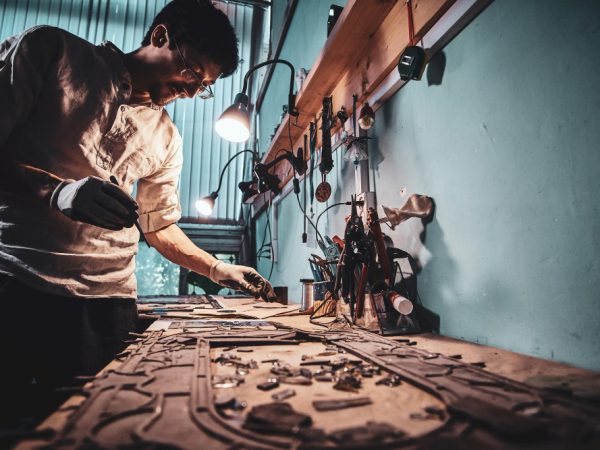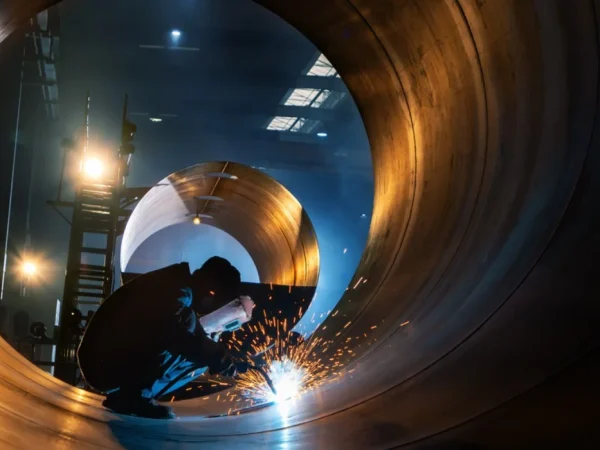Innovation is the heartbeat of the capital good industry, driving progress and shaping the future of manufacturing, construction, and infrastructure development. From advanced machinery to cutting-edge technologies, the sector continues to evolve rapidly, meeting the demands of an ever-changing global market. In this article, we delve into 10 game-changing innovations revolutionising the Capital Good Industry, showcasing how these advancements are reshaping production processes, improving efficiency, and enhancing sustainability.
Robotics and Automation: Transforming Production Lines in the Capital Good Industry
Robotics and automation have emerged as pivotal components reshaping production lines within the Capital Good Industry. These technologies streamline manufacturing processes, enhancing efficiency, precision, and scalability. Within this sector, robotics handle repetitive tasks with unparalleled accuracy, reducing production times and minimising errors. The advent of collaborative robots (cobots) further revolutionises factory operations by working alongside human operators, fostering safer and more collaborative work environments.
Additive Manufacturing: Redefining Prototyping and Production in the Capital Good Industry
Additive manufacturing, commonly referred to as 3D printing, is redefining prototyping and production processes within the Capital Good Industry. This innovative technology enables rapid prototyping and on-demand production of complex components. By leveraging additive manufacturing, manufacturers can create intricate designs with unprecedented precision, thereby reducing material waste and lead times. From aerospace to medical industries, additive manufacturing offers unparalleled design freedom and customization options, significantly impacting manufacturing processes within the Capital Goods Industry.
Internet of Things (IoT) Integration: Smart Factories for Enhanced Efficiency in the Capital Good Industry
The integration of Internet of Things (IoT) devices within the Capital Goods Industry has led to the emergence of smart factories, characterised by interconnected systems facilitating real-time monitoring, analysis, and optimization of production processes. IoT-enabled equipment collects vast amounts of data, providing valuable insights into equipment performance, energy consumption, and predictive maintenance needs. By leveraging this data, manufacturers can proactively identify inefficiencies, minimise downtime, and optimise resource utilisation, ultimately enhancing productivity and reducing operational costs.
Artificial Intelligence (AI) in Equipment Maintenance: Predictive Solutions in the Capital Good Industry
Artificial Intelligence (AI) is revolutionising equipment maintenance strategies within the Capital Goods Industry by introducing predictive solutions. Machine learning algorithms analyse historical data and real-time performance metrics to predict potential equipment failures before they occur. This proactive approach enables timely maintenance interventions, minimising costly downtime and optimising equipment reliability. By harnessing AI-driven solutions, manufacturers can extend asset lifespan, reduce maintenance costs, and enhance overall operational efficiency.
Renewable Energy Solutions: Sustainable Power for Machinery in the Capital Good Industry
The integration of renewable energy solutions within the Capital Goods Industry is driving sustainability initiatives and reducing environmental impact. Hybrid and electric-powered machinery offer significant benefits by reducing carbon emissions and dependence on fossil fuels. Additionally, renewable energy solutions provide manufacturers with greater energy independence and resilience against fluctuating energy prices. As sustainability concerns continue to grow, the adoption of renewable energy technologies is becoming increasingly vital for companies within the Capital Goods Industry.
Advanced Materials: Lightweight and Durable Components in the Capital Good Industry
Advances in material science have facilitated the development of lightweight and durable materials within the Capital Goods Industry. Composite materials, such as carbon fibre and advanced polymers, offer superior strength-to-weight ratios, enabling the production of lighter yet robust components for various applications. These innovative materials not only reduce fuel consumption and operating costs but also improve product durability and longevity, contributing to a more sustainable and resource-efficient manufacturing ecosystem.
5G Connectivity: Revolutionising Communication and Data Transfer in the Capital Good Industry
The rollout of 5G networks is revolutionising communication and data transfer within the Capital Goods Industry, unlocking new opportunities for connectivity, collaboration, and real-time decision-making. High-speed, low-latency 5G connectivity enables seamless communication between machinery, devices, and personnel, facilitating remote monitoring, control, and diagnostics. This enhanced connectivity paves the way for the widespread adoption of autonomous vehicles, remote operation of equipment, and immersive virtual collaboration experiences, driving productivity gains and operational efficiencies across the value chain.
Augmented Reality (AR) and Virtual Reality (VR) in Training and Design in the Capital Good Industry
Augmented Reality (AR) and Virtual Reality (VR) technologies are transforming training, design, and maintenance processes within the Capital Goods Industry. AR-enabled maintenance applications provide technicians with real-time visualisations and step-by-step instructions, improving troubleshooting efficiency and reducing downtime. VR-based design tools allow engineers to create and test prototypes in virtual environments, accelerating the product development cycle and minimising costly physical prototypes. As AR and VR technologies continue to mature, their integration into capital goods workflows promises to drive innovation and efficiency across various sectors.
Blockchain in Supply Chain Management: Enhancing Transparency and Security in the Capital Good Industry
Blockchain technology is revolutionising supply chain management within the Capital Goods Industry by offering enhanced transparency, traceability, and security throughout the product life cycle. By creating immutable records of transactions and interactions, blockchain enables stakeholders to track the movement of goods, verify product authenticity, and ensure compliance with regulatory standards. Smart contracts powered by blockchain automate contractual agreements and payments, streamlining procurement processes and reducing administrative overhead. As concerns about supply chain resilience and integrity grow, the adoption of blockchain solutions is becoming increasingly essential for companies seeking to mitigate risks and improve operational efficiency.
Cognitive Computing for Complex Problem Solving in the Capital Good Industry
Cognitive computing, including technologies such as natural language processing and machine learning, empowers manufacturers within the Capital Goods Industry to tackle complex challenges and drive innovation in product development and optimization. Advanced analytics algorithms analyse vast datasets, uncovering hidden patterns, insights, and opportunities for process improvement. Cognitive computing systems assist engineers in optimising product designs, predicting market demand, and identifying cost-saving opportunities. By augmenting human intelligence with machine learning capabilities, cognitive computing enables companies to make data-driven decisions with confidence, driving continuous improvement and innovation within the Capital Goods Industry.
Conclusion
The Capital Goods Industry is undergoing a profound transformation fueled by innovation and technological advancements. From robotics and additive manufacturing to IoT integration and AI-driven solutions, these innovations are reshaping production processes, driving efficiency, and fostering sustainability. As companies within the industry embrace these game-changing technologies, they position themselves for growth and competitiveness in the global market. By leveraging these advancements, manufacturers can optimise their operations, reduce costs, and meet the evolving demands of customers and regulatory standards. The future of the Capital Goods Industry is bright, with continued innovation paving the way for enhanced productivity, sustainability, and success.
FAQs
Q1. How are robotics and automation reshaping production lines within the Capital Goods Industry?
Robotics and automation are revolutionising production lines by automating repetitive tasks, increasing precision, and streamlining processes. Robots are being employed for tasks ranging from assembly and welding to packaging and material handling. By integrating robotics into production lines, manufacturers can improve efficiency, reduce labour costs, and enhance overall productivity.
Q2. What advantages does IoT integration offer for enhancing efficiency in smart factories?
IoT integration enables real-time monitoring, analysis, and optimization of production processes in smart factories. IoT devices collect data from equipment and machinery, providing insights into performance, maintenance needs, and energy consumption. This data allows manufacturers to identify inefficiencies, reduce downtime, and optimise resource utilisation, ultimately enhancing efficiency and productivity.
Q3. How does AI-powered predictive maintenance benefit equipment reliability and efficiency in the Capital Goods Industry?
AI-powered predictive maintenance utilises machine learning algorithms to analyse data and predict potential equipment failures before they occur. By identifying issues early, manufacturers can schedule maintenance proactively, minimising downtime and reducing the risk of costly repairs. This approach improves equipment reliability, extends asset lifespan, and enhances overall operational efficiency within the Capital Goods Industry.
Q4. What role do renewable energy solutions play in promoting sustainability within the Capital Goods Industry?
Renewable energy solutions, such as solar and wind power, offer sustainable alternatives to traditional energy sources within the Capital Goods Industry. By integrating renewable energy technologies into machinery and equipment, manufacturers can reduce carbon emissions, lower energy costs, and enhance environmental sustainability. Additionally, renewable energy solutions provide companies with greater energy independence and resilience against fluctuating energy prices.
Q5. How are AR and VR technologies utilised for training and design in the Capital Goods Industry?
Augmented Reality (AR) and Virtual Reality (VR) technologies are transforming training and design processes within the Capital Goods Industry. AR-enabled maintenance applications provide technicians with real-time visualisations and instructions, improving troubleshooting efficiency and reducing downtime. VR-based design tools allow engineers to create and test prototypes in virtual environments, accelerating the product development cycle and minimising costly physical prototypes. These technologies enhance learning, visualisation, and collaboration, driving innovation and efficiency within the industry.
Also read: Which of the Following is NOT the Definition of Quality? 7 Surprising Truths Revealed














